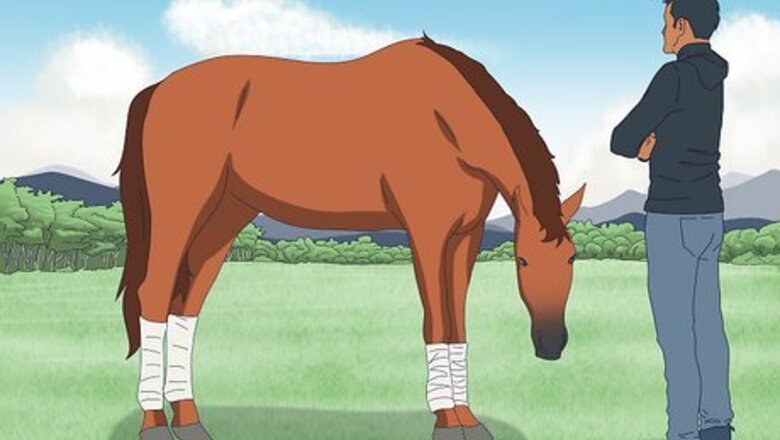
views
X
Expert Source
Kate JutagirEquestrian Specialist & Trainer
Expert Interview. 31 March 2020.
With patience, consistency, and firm leadership, you can teach your horse to respect you by focusing on three exercises: yielding to pressure, backing on cue, and waiting until cued to approach.
Knowing What Respect Means
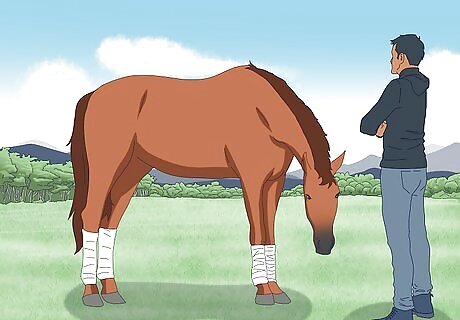
Know when your horse respects you. Before you can train a horse to respect you, you need to know what respect (and disrespect) looks like. Obviously, if your horse is biting, kicking, or rearing, then you have a respect issue, but there are also more subtle signs, like bumping you with his shoulder, tossing his head, or nudging you with his nose. You can tell your horse respects you if: You can lead your horse on a loose rope beside you, walking side by side with 3 to 4 feet (0.91 to 1.2 m) between you and your horse. You should not be pulling your horse. Your horse follows you when you back up or walk forward. You may need to prompt your horse, especially for backing up. Lift the lead rope high and rhythmically bump your horse's neck to get his attention. Your horse moves his head away when you walk into his face area. You may need to give your horse some direction by pointing your finger or holding up the lead rope. If your horse moves his head into you, you have a respect problem. Your horse moves his hindquarters away when you walk to his rear. If your horse moves to block you with his shoulder, then you have a respect problem.
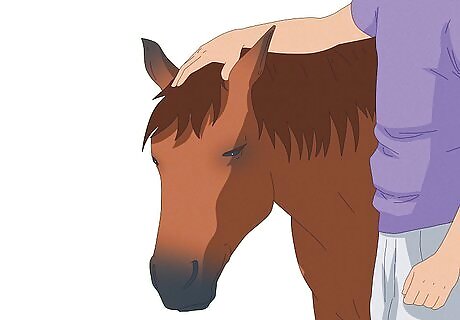
Be aware of what dominance means to a horse. Horses in a herd naturally establish a hierarchy. The head horse is the one who can get the other horses to move on command. So if you step out of the way when your horse swings its head into your space, or if you let your horse push up against you, then you are communicating to your horse that you are a follower and he is the leader.
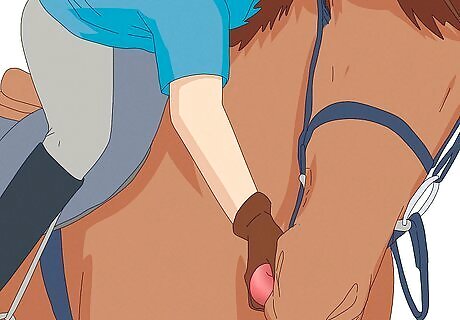
Don't confuse love and respect. It's good to love your horse, but love alone will not produce respect. If you pet, brush, and give treats to your horse without ever asking him to move or doing anything to establish a mutually respectful relationship, you're going to end up with a horse that shows all the signs of disrespect: tossing its head, pushing you, and maybe even biting.
Being Your Horse's Leader
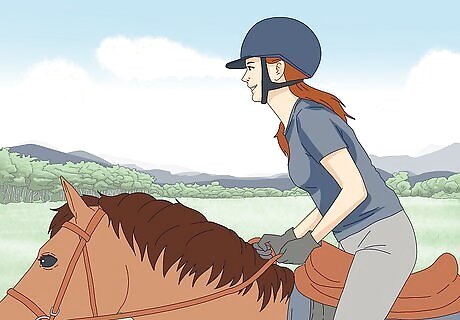
Be a leader. To earn your horse's respect, you will need to be his leader. That means training your horse to move on cue. The more easily you can get your horse to move his feet, the more your horse respects you. And no matter how well-trained your horse is, if he doesn't respect you, you will have problems controlling him. Try leading your horse through simple vocal commands like "walk" or "whoa." These are useful in training your horse to move forward and slow down, respectively. Use these vocal commands consistently to establish yourself as a leader and form a respectful partnership with the horse.
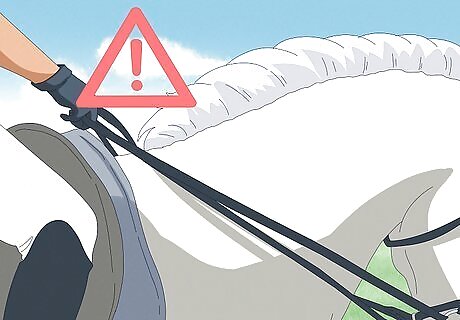
Avoid physically reprimanding your horse whenever possible. With dangerous horses, in situations where you need to protect the horse, yourself, or others, a physical reprimand may be necessary. If you do reprimand your horse physically, be sure to continue until he steps out or your space, or you will have failed to assert dominance. Generally, though, you should use gentler training techniques that help to foster trust and companionship between you and your horse.
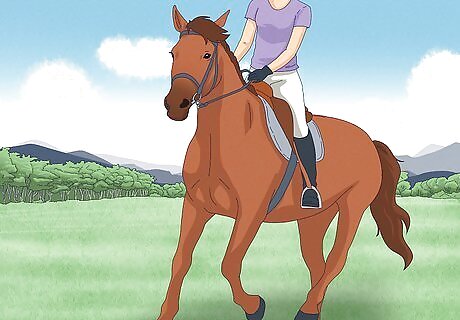
Keep your horse busy. Especially when first training your horse, keeping him busy responding to your cues will help cut off any unwanted behavior. Whenever your horse's attention drifts or he shows signs of disrespect, practice yielding to pressure, backing, and waiting to enter your space. Let him know that not being respectful means hard work!
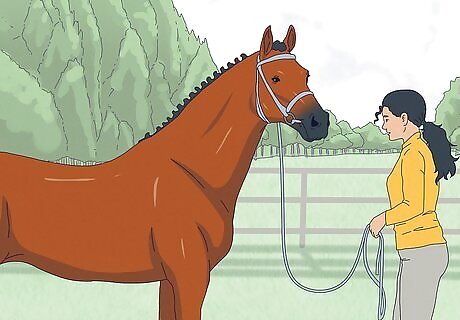
Make training a part of your everyday routine with your horse. As well known horse-trainer Clinton Anderson notes, “Horses don't stay the same. Every day they either get a little bit better or a little bit worse.” Don't think that you can train your horse once and expect perfect behavior from that day on. Horses need repetition to reinforce appropriate behavior. Even after your horse has mastered the drills below, keep incorporating them into your interactions. Ask your horse to yield to pressure several times when tacking him. If your horse drags behind or gets too far in front of you when walking on a lead, stop and back him up.
Training Your Horse to Respect You
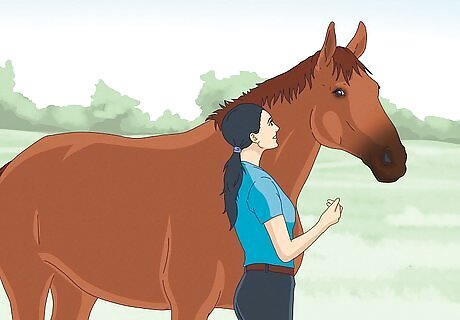
Build trust. Teaching your horse that you are both safe and a joy to be around will make training for respect much easier. Every chance you get, rub your horse all over his body, scratch his itchy spots, and generally show you love him. If your horse objects when you rub an area, back off and return to it slowly. When your horse accepts being rubbed with your hands, try other objects like ropes, saddle pads, and bridles.
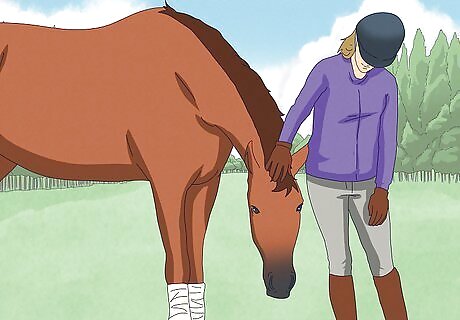
Teach your horse to give to pressure. When a horse A pushes horse B, and horse B gives ground, then horse A has just communicated dominance. You need to practice doing the same with your horse, so that when you press on any part of his body, he gives way. This not only helps establish respect, it is also very useful in handling your horse on a daily basis. Start with your horse's poll (the head just behind the ears), pressing down until your horse lower his head, even if it takes several minutes. Keep practicing until your horse lowers his head quickly every time you apply light pressure. The goal is for your horse to yield to light pressure. Don't push too hard. And even if it takes more pressure at first, lighten the pressure as your horse learns, so that eventually he is moving away at a touch. Move on to the shoulder, hip, barrel, muzzle, legs, and other parts of the body. Make sure your horse is responding correctly every time you apply pressure before moving on. Keep up practice with all parts of your horse's body, combining your practice with rubbing your horse as in the previous step. Spend 5 minutes a day rubbing your horse, asking him to yield to pressure, rubbing so more, and then asking again, etc.
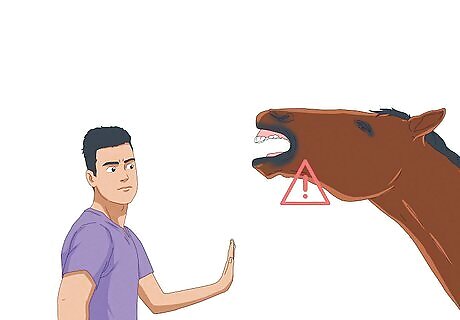
Train your horse to back away on cue. A quick, responsive back up is the foundation of training a horse to respect you and your space. Teaching to back on cue will take time and several sessions, but is worth it. Stand 3 feet in front of your horse, holding a slack lead rope. Be sure it does not become taut at any point during the exercise. Hold up the lead rope while you point with your finger. Wiggle the lead rope gently back and forth. If your horse does not walk backward, wiggle harder. Continue wiggling harder until you are jerking the horse's halter enough for it to be uncomfortable. The goal is not to cause pain, but mild discomfort. As soon as your horse steps backward, stop wiggling. Pet and praise your horse. Keep practicing until your horse backs at only a slight wiggle of the lead rope, or even at a wiggle of your finger. Steadily increase the distance you ask your horse to back before rewarding him – 2 feet (0.61 m), then 4, 6, 8… up to 10 or 20 feet.
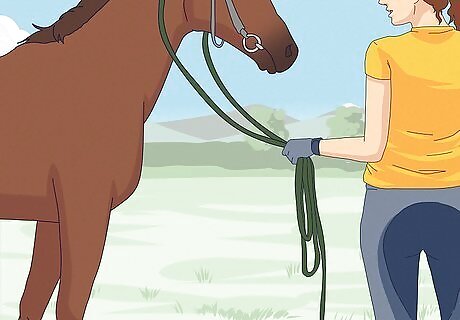
Have your horse wait for permission to enter your space. This is a very important lesson to teach and then constantly reinforce. Whenever, your horse misbehaves, you can use this exercise to calm him and reestablish your dominance. Once your horse has mastered backing up, hold the lead rope and wiggle it until he has backed 10 feet (3 m) from you. Wait. If your horse stars towards you without a cue from you, immediately ask him to back up to 10 feet (3 m) again. Continue this until your horse can wait patiently. Cue your horse to come to you. Wiggle the lead rope to ask him to stop 3 feet (0.91 m) away. Once he is stopped, pet him and give praise. Once your horse has mastered this, make it more difficult by turning your back or moving after your horse has backed away to 10 feet. Keep practicing. Whenever your horse becomes disrespectful, you can ask him to back away and wait for your cue. If he walks ahead of you when leaving the stall, or nudges you for a treat, back him up.
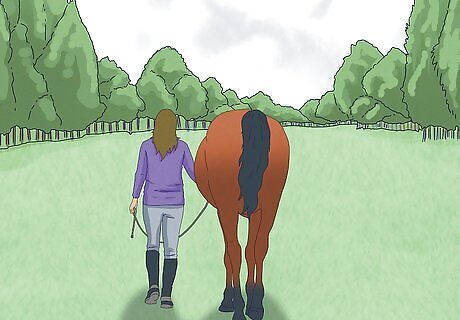
Maintain your personal space. Even after you've trained your horse to wait and back up on command, you'll still need to maintain command on a daily basis in all situations. In particular, you need to be careful not to let your horse push you around. If you have taught him to yield to pressure and back up, this will be easier. If your horse swings his head towards you, touch his jawbone to ask him to yield. If he does not, push with force. Don't let him push you around. If your horse tries to step on you, move in front of your horse and ask him to back and wait. If your horse is in motion at the time, do not move in front of him as he could easily trample you. If your horse attempts to bite you, immediately ask him to back away. If you are in a stall, slap his neck to show displeasure, then move in front of him and make him back away in the stall. Even a step will do. Tip: Never give your horse treats when he nuzzles you. This can lead to nipping.




















Comments
0 comment